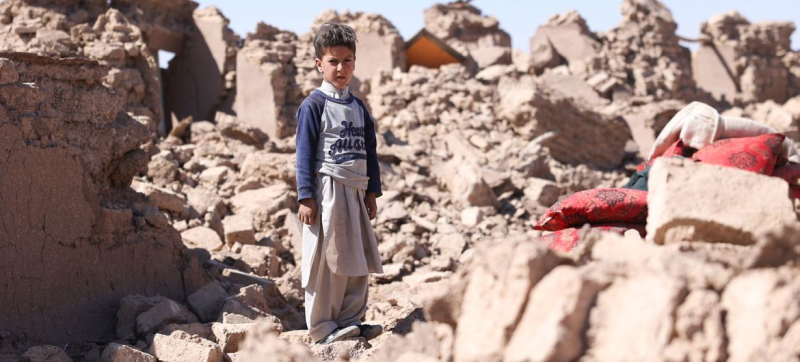- IAEA Chief Calls for Renewed Commitment to Non-Proliferation |
- UN Aid Chief Warns Humanitarian Work Faces Collapse |
- Arab-Islamic Summit yields limited action over Israeli strike on Doha |
- National Consensus Commission term extended till October 15 |
- EU Helping BD prepare for free, fair elections: Envoy Miller |
UN Aid Chief Warns Humanitarian Work Faces Collapse

A child stands amidst the ruins left in the aftermath of the devastating October 2023 earthquakes in Herat, Afghanistan.
“Underfunded, overstretched and under attack” is how the United Nations’ top aid official has described the UN and the support it is providing to the humanitarian sector.
Speaking on Monday to journalists at UN Headquarters in New York, Tom Fletcher, who heads the Office for the Coordination of Humanitarian Affairs (OCHA), said: “We have only 19 per cent of what we need.”
The international community is currently facing multiple humanitarian crises worldwide, including conflict-driven emergencies in the Democratic Republic of the Congo, Gaza, Sudan, Syria, Ukraine and Yemen. Other crisis hotspots include Afghanistan, Haiti, Myanmar and the Sahel.
The Global Humanitarian Overview 2025 (GHO), an annual assessment of global humanitarian needs and responses, was launched last December and covers 180 million vulnerable people across 70 countries. While the GHO calls for $44 billion, latest figures show that just under $15 billion has been received to date.
So far in 2025, three crises – in the Occupied Palestinian Territory, Ukraine and Sudan – have absorbed almost a quarter of all funding. The top five donors, according to OCHA’s Financial Tracking Service, are the European Commission, the United States and the United Kingdom, followed by Japan and Germany.
According to Mr Fletcher, hundreds of aid organisations have shut down, and the humanitarian sector has shrunk to just one-third of its size compared with 10 months ago. Meanwhile, OCHA has lost 20–25 per cent of its staff over the past year.
In June, OCHA launched a “hyper-prioritised” appeal for $29 billion to reprioritise individual country humanitarian plans with the goal of saving 114 million lives. This $29 billion represents just one per cent of what the world is projected to spend on defence this year. “What does this say about our collective priorities?” Mr Fletcher asked.
This year alone, six million more children have been forced out of school globally, according to the UN Children’s Fund (UNICEF). Meanwhile, the Office of the UN High Commissioner for Refugees (UNHCR) has warned that 11 million refugees may no longer get the help they need.
In Gaza, more than half a million people are currently facing extreme hunger, a figure expected to rise above 640,000 by the end of the month, according to the latest Integrated Food Security Phase Classification (IPC) report. “We need a ceasefire now,” urged the humanitarian chief.
Sudan, facing the world’s largest humanitarian crisis, is expected to be a major topic of discussion at the forthcoming meeting of world leaders at the UN from 22 September. Haiti is also under the spotlight, where sexual and gang violence remain widespread. “Women were taking contraception in advance when approaching checkpoints, anticipating acts of sexual violence,” said Mr Fletcher.
The year 2025 has also marked a record for aid workers killed in the line of duty, with over 270 killed compared with 380 last year.
“We need to see more anticipatory, more preventive, more efficient, and more local approaches,” Mr Fletcher stressed.
At a time when it is “unfashionable to be defending institutions, defending structures, hierarchies, and order – the alternative is disorder and chaos,” he said.
“We must grieve for what has gone, we must fight for what must be saved, and we must imagine what we can be in the future.”

